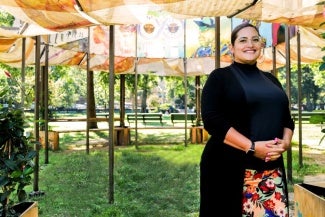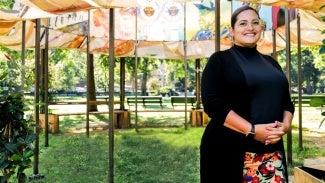
Expanding the narrative
How can architects prioritize health and equity for all communities?

Venesa Alicea-Chuqui, AIA, NOMA, has devoted her career to encouraging community engagement through design practices. Alicea-Chuqui is a current Equity in Action Presidential Fellow at Kean University in New Jersey, as well as a core organizer of Dark Matter U, where she works toward an anti-racist model of design education and practice with her colleagues. We talked with Alicea-Chuqui about how she’s making strides for a more inclusive profession, for both architects and the people they serve.
I spent my first four years in Puerto Rico while my uncle and grandfather were building the house that I would spend my summers in [during childhood]. In my head, it was always part of this family dream to have the ability to build a house for your family. I think I was drawn to architecture because I wanted to build a house for my mom, and I watched my uncle do that for his dad.
That house was destroyed by Hurricane Maria. That was a big catalyst for me in transitioning my practice—trying to rethink where and how I work, or what the role of architects could be.
A lot of my current work has been trying to figure out, how do you support communities to [meet] the needs that they have for architects or planners? How do you create policies or funding mechanisms that will support the community’s hiring of a designer? Maybe their building needs to be retrofitted for energy efficiency reasons. Maybe they want to reconsider the design of the neighborhood, or the business improvement district. How do we make sure that these businesses have the tools they need to be up to par with code or with new energy requirements?
A lot of the architect’s work is for the client and the developer. So many projects in New York that I’m in proximity to are so developer-driven. They feel disconnected from the final stakeholder. Part of what I’ve been looking at in my research is, how do we prioritize people in this process and create spaces that are healthy and equitable? I’ve observed that communities have sometimes had very bad experiences with buildings that don’t work, and there can be a lack of trust. Design justice, for me, means that we can use design as a tool to ensure that the spaces of the built environment are equitable for the people using them—and defining that equity is different for different people.
I’ve been involved with DMU since its inception in the summer of 2020, when there were a series of collective conversations and unrest related to the murders of George Floyd and Breonna Taylor. We wanted to think about what an anti-racist design education would look like—about how policy, systemic racism, and what we’re taught in architecture school are one-sided. How do we include more voices and expand the narrative?
